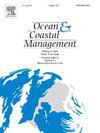Optimistic climate mitigation scenario halves projected range loss in a neotropical dolphin
IF 5.4
2区 环境科学与生态学
Q1 OCEANOGRAPHY
引用次数: 0
Abstract
Ocean warming, acidification, and deoxygenation are expected to intensify without significant climate mitigation. In the tropics, rising ocean temperatures may push marine species to their thermal limits, leading to redistributions and cascading effects on communities and ecosystems. We evaluate how future climate change scenarios could impact the habitat suitability of an endemic species of the western tropical Atlantic Ocean, the Guiana dolphin, Sotalia guianensis. Using data from systematic surveys conducted between 1987 and 2023 complemented by open-source databases, we built the most comprehensive occurrence dataset for the species and developed ensemble Species Distribution Models to predict future distributions under the latest CMIP6 projected scenarios—‘optimistic’ (SSP1-2.6), ‘intermediate’ (SSP2-4.5), ‘pessimistic’ (SSP5-8.5)—using expert knowledge to validate model predictions in the present. Our models project substantial range contractions under all climate scenarios. By 2070, under the pessimistic scenario, suitable habitat is expected to decline by 46.9 %, nearly doubling the habitat loss projected under the optimistic scenario (23 %). Guiana dolphins are expected to lose habitat in northeastern Brazil and along the Caribbean coast (except Costa Rica). Remaining suitable areas are expected to become fragmented and confined to southeastern and southern Brazil, where the coastal zone is the most urbanized and degraded. Currently, only 21.6 % of the predicted Guiana dolphin range overlaps with Marine Protected Areas (MPAs), and just 1.8 % is covered by MPAs that prohibit extractive activities—a small proportion expected to decline from 19 % to 14 % in the future. Our study highlights the urgent need to incorporate climate change into conservation strategies for coastal tropical marine predators.
乐观的气候缓解情景使新热带海豚的预计范围损失减半
如果没有显著的气候减缓,预计海洋变暖、酸化和脱氧将加剧。在热带地区,不断上升的海洋温度可能会将海洋物种推向其热极限,导致对群落和生态系统的重新分配和级联效应。我们评估了未来气候变化情景如何影响热带大西洋西部特有物种圭亚那海豚(Sotalia guianensis)的栖息地适宜性。利用1987年至2023年的系统调查数据,结合开源数据库,建立了最全面的物种发生数据集,并建立了综合物种分布模型,预测了最新CMIP6预测情景下的未来分布——“乐观”(SSP1-2.6)、“中间”(SSP2-4.5)、“悲观”(SSP5-8.5),并利用专家知识验证了目前的模型预测。我们的模型预测了在所有气候情景下范围的大幅收缩。到2070年,在悲观情景下,适宜栖息地预计减少46.9%,几乎是乐观情景下预测的栖息地损失(23%)的两倍。圭亚那海豚预计将在巴西东北部和加勒比海沿岸(哥斯达黎加除外)失去栖息地。剩余的适宜地区预计将变得支离破碎,并局限于巴西东南部和南部,那里的沿海地区城市化程度和退化程度最高。目前,圭亚那预测的海豚活动范围中只有21.6%与海洋保护区(MPAs)重叠,只有1.8%被禁止开采活动的MPAs覆盖,这一小部分预计将在未来从19%下降到14%。我们的研究强调了将气候变化纳入沿海热带海洋捕食者保护策略的迫切需要。
本文章由计算机程序翻译,如有差异,请以英文原文为准。
求助全文
约1分钟内获得全文
求助全文
来源期刊

Ocean & Coastal Management
环境科学-海洋学
CiteScore
8.50
自引率
15.20%
发文量
321
审稿时长
60 days
期刊介绍:
Ocean & Coastal Management is the leading international journal dedicated to the study of all aspects of ocean and coastal management from the global to local levels.
We publish rigorously peer-reviewed manuscripts from all disciplines, and inter-/trans-disciplinary and co-designed research, but all submissions must make clear the relevance to management and/or governance issues relevant to the sustainable development and conservation of oceans and coasts.
Comparative studies (from sub-national to trans-national cases, and other management / policy arenas) are encouraged, as are studies that critically assess current management practices and governance approaches. Submissions involving robust analysis, development of theory, and improvement of management practice are especially welcome.
 求助内容:
求助内容: 应助结果提醒方式:
应助结果提醒方式:


